Overview of "Yamaha Motor Group Environmental Plan 2050"
Introducing an overview of the Yamaha Motor Group Environmental Plan 2050
Contents
- Environmental Plan 2050
- Task Force on Climate-related Financial Disclosures (TCFD) items

- Governance
- Strategy
- World in a 1.5°C Scenario and 2°C Scenario
- Scenario Analysis
- Major Risks Associated with Transitioning to a Low Carbon Society
- Short-term, Medium-term, and Long-term Risks and Opportunities
- Yamaha Motor's Adaptation Measures
- Yamaha Motor's Mitigation Measures
- Yamaha Motor’s Net-zero CO2 Emissions (Carbon Neutrality) Strategy
- Risk Management
- Indicators and Targets
- Environmental technology briefing
Environmental Plan 2050

The expectations of international society are mounting toward those companies that proactively undertake Environmental, Social, and Governance (ESG) issues, such as the signing of the Paris Agreement on climate change, and the UN’s Sustainable Development Goals (SDGs).
Yamaha Motor has a diverse range of products that are actively used outdoors in nature, whether on land, sea, or in the air. Yamaha’s strength is creating lightweight, compact products with smaller environmental footprints, and the Company has achieved growth by providing freedom, mobility, and richness to the lives of people around the world.
Going forward, Yamaha Motor will continue aiming for achievement of a sustainable society. As a company that proactively addresses ESG issues, we established the Yamaha Motor Group Environmental Plan 2050.
In the Yamaha Motor Group Environmental Plan 2050, we set up goals to achieve by 2050, with climate change, recycling of resources, and biodiversity as priority action areas, as well as targets to achieve by 2035 as milestones. We will be promoting our activities by formulating a medium-term plan every three years. We will offer new excitement and a more fulfilling life for people all over the world by achieving our targets.
Overview of the Plan
Yamaha Motor aims for net-zero CO2 emissions (carbon neutrality) for the whole product life cycle.
| Action Themes | 2050 Targets | Priority Actions | |
|---|---|---|---|
| Climate Change  |
1 | 1. Reduction of CO2 emissions from use of products by users by 90% or more as compared to 2010 |
※ICE: internal combustion engine |
| 2 | Net-zero CO2 emissions (carbon neutrality) for the entire life cycle |
|
|
| Resource Recycling  |
3 | Effective utilization of limited resources and promotion of recycling |
|
Biodiversity |
4 | Strengthening of environmental conservation and biodiversity promotion activities in various countries and regions |
|
Management |
5 | Management |
|
2050 Society
The current global population of 7.7 billion is predicted to reach 9.7 billion by 2050, increasing 2 billion over the next three decades. Economic growth in Africa and India, among other regions, will drive the world's consumption of primary energy, increasing 1.4-fold from the current level of 13.9 billion tons to 19.2 billion tons by 2050. Based on these predictions, it is assumed that the world will face a significant shortage of resources and energy in 2050.
In terms of the global environment, the world is moving toward decarbonization in an effort to reduce CO2 emissions—believed to be the primary cause of global warming—shifting from fossil fuels to alternative energy sources in the use of primary energy. In light of these predictions and assumptions concerning society and our business environment in 2050, we identified long-term environmental issues.


Africa, India, and China combined account for 55% of the total population.
(Africa: 2.4 billion / India: 1.6 billion / China: 1.4 billion)
Source: Based on data from World Population Prospects 2019


Use of fossil fuels, which cause global warming, makes up 83%.
Source: Based on data from IEA's World Energy Balances
Some experts predict that if the economic development of emerging nations continues to drive the rapid growth of demand for mineral and fossil resources, all known deposits of underground mineral resources will be exhausted by 2050.

Stacked bar graph: Representing different metals
Red line: Total material requirement of deposit amount
Source: Based on National Institute for Materials Science data
Risks concerning Global Reduction of Greenhouse Gases
The Paris Agreement, an international treaty adopted at the 21st Conference of the Parties (COP21) to the UN Framework Convention on Climate Change, was ratified by 185 countries on April 26, 2016. With the aim of enhancing worldwide efforts against the threat of climate change, the Paris Agreement established "mitigation" through reduction and absorption of greenhouse gas emissions and "adaptation" to the impacts of greenhouse gases as two key elements in achieving the goal of keeping the rise in the global average temperature to well below 2°C above pre-industrial levels, or to limit it to 1.5°C by the end of the 21st century. According to the "Special Report on Global Warming of 1.5°C," even if all the countries fulfilled the nationally determined contributions (NDCs) for 2030 that they submitted in connection with the Paris Agreement, we will still be 12 gigatons short of achieving the 2°C target, and 29 gigatons short with regard to the 1.5°C target.
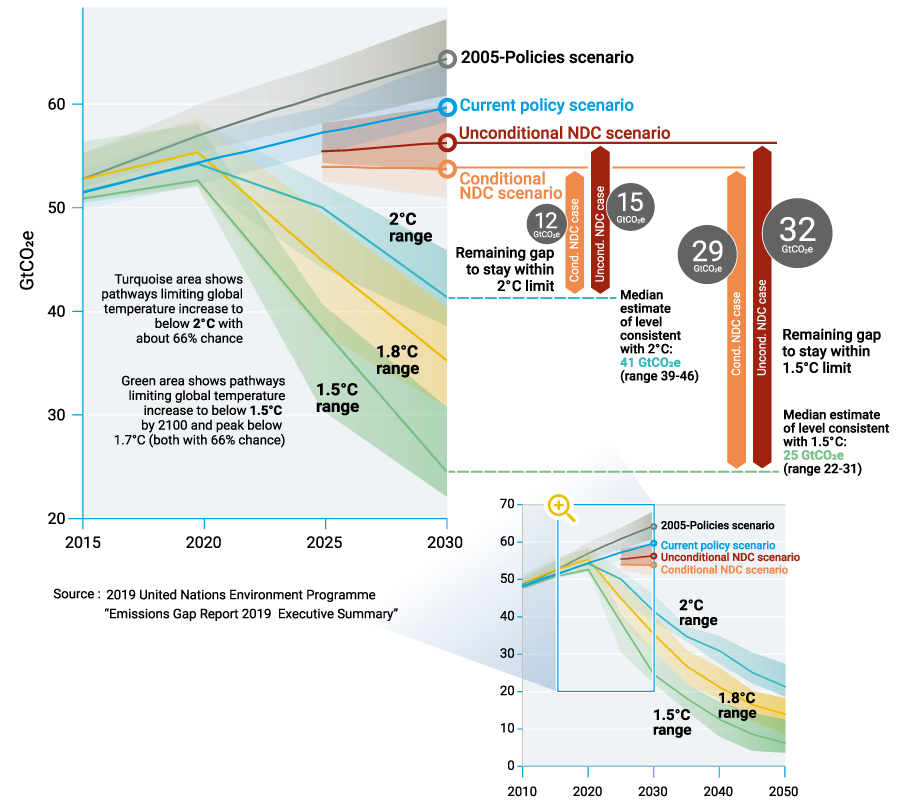
Identification of Material Issues (Materiality)
We intend to address not just climate-related risks but also a variety of social issues in ways that embody the unique style of Yamaha. Resolving social issues is also very important for Yamaha Motor's sustainable growth, and therefore, in formulating our long-term vision and medium-term management plan, we have used the steps shown below to identify material social issues that we can resolve using our strengths.
Selected Social Issues
* Text in red: climate-related issues
| Material issue areas | |||
Importance to stakeholders |
|
|
|
|
|
|
|
|
|
|
|
Importance to Yamaha Motor
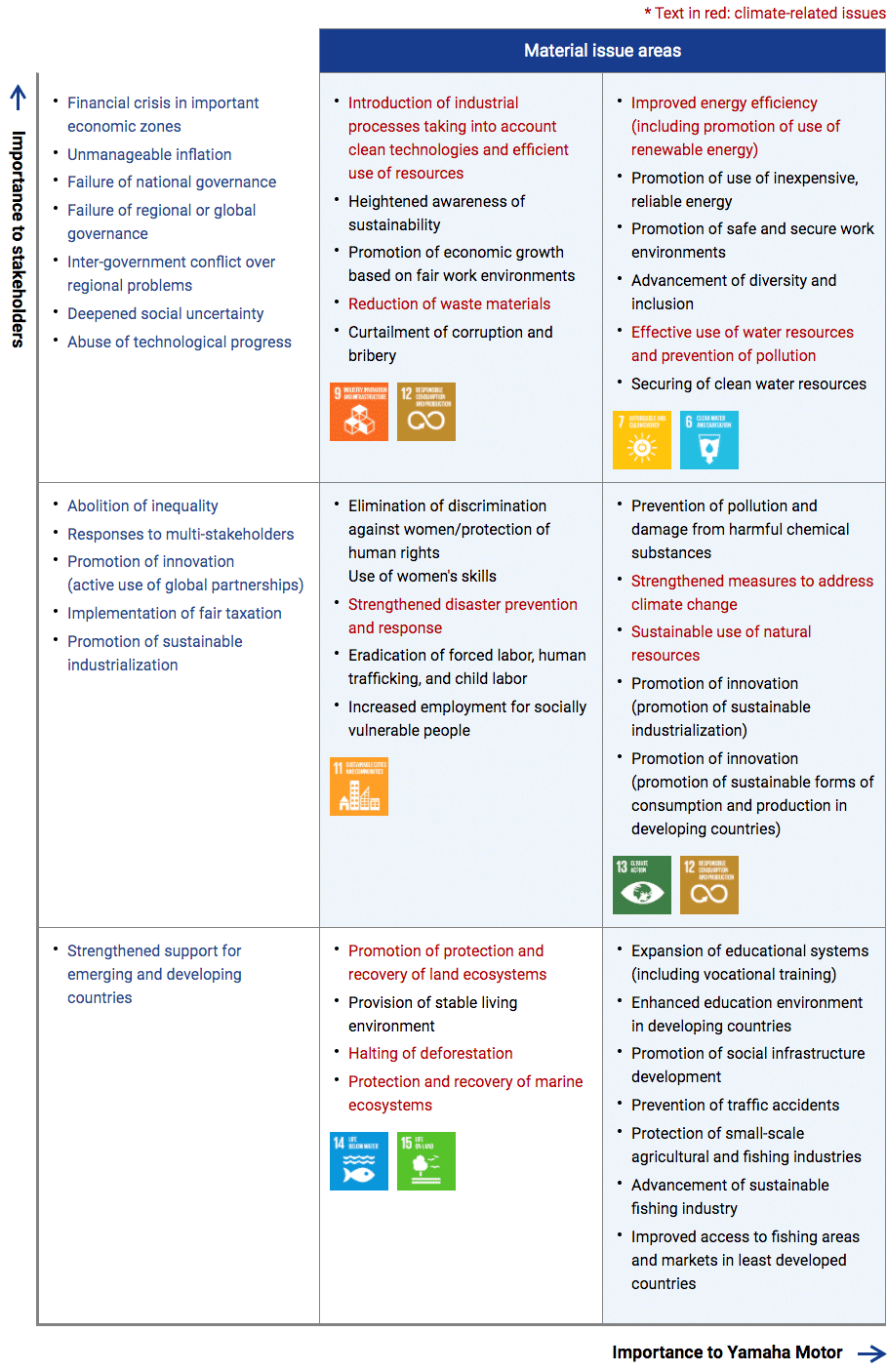
Climate-related Risks and Opportunities
Material environmental and social issues |
|
|
|
|---|
Action Themes |
Climate Change  |
Resource Recycling  |
Biodiversity  |
|---|---|---|---|
Risks |
|
|
|
Opportunities |
|
|
|
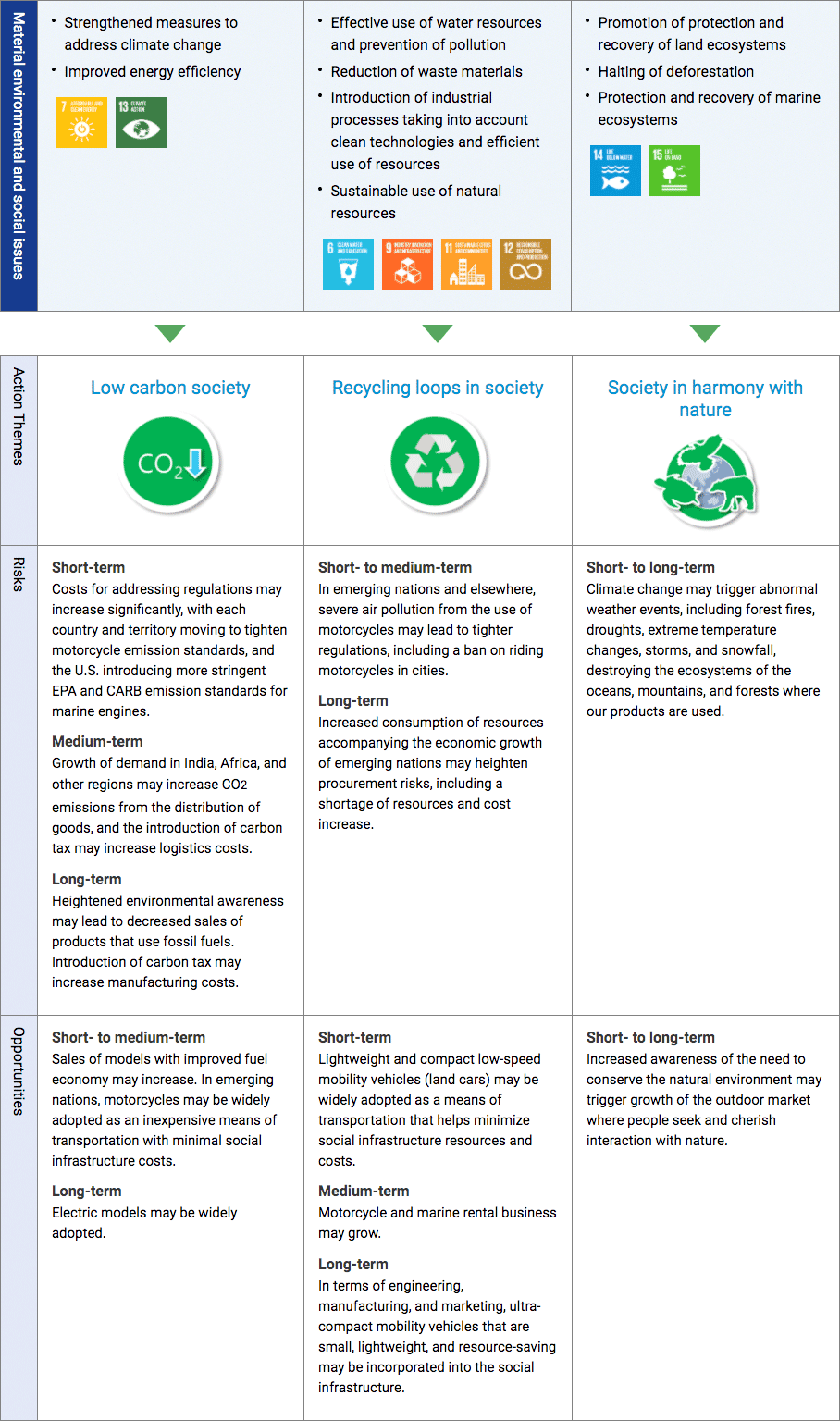
Impact of CO2 Emissions
The world produced 33.5 billion tons of CO2 emissions in 2018. Of this amount, products accounted for just 0.06% of the total as a source of emissions and are therefore a mobility option with an extremely low environmental impact. In 2020, CO2 emissions across the Yamaha Motor Group's entire supply chain were 130,174 t-CO2 for Scope 1, 312,359 t-CO2 for Scope 2, 23,293,403 t-CO2 for Scope 3, and 23,735,936 t-CO2 overall. Scope 3 "Category 11. Use of products sold" accounted for 82.7%, followed by "Category 1. Purchased products and services (Emissions associated with sourcing of raw materials)" at 13.1%. In setting reduction targets for CO2 emissions, we recognize the importance of improving the fuel (electric) efficiency of our products, promoting the adoption of next-generation mobility vehicles, and using resources efficiently.


Task Force on Climate-related Financial Disclosures (TCFD) items
1. Governance

Roles of the Board of Directors of an Organization in Overseeing Climate-related Issues
Yamaha Motor contributes to solutions to issues that involve realizing a sustainable society in a variety of countries and regions by utilizing its businesses and human resources, tangible assets and know-how built through its business operations. At the same time, we aim to be a sustainable company, as a member of the global society. Therefore, under the Groupwide "Sustainability Basic Policy," we position "environment and resources," "transportation, education and industry," "innovation" and "issues related to the promotion of human resources utilization" as material social issues that require the attention of Yamaha Motor in the medium- to long-term growth strategies in order to achieve the internationally agreed targets of the SDGs. We also set the KPIs associated with the goals of each business to seize growth opportunities. Meanwhile, we believe that dealing with social issues is an important part of risk management. We have signed the UN Global Compact, and we appropriately deal with global risks that impede sustainability by practicing the principles of "human rights," "labor," "environment" and "anti-corruption." We properly disclose information so that our stakeholders can easily obtain information on these initiatives.
The Board of Directors formulates policies on dealing with issues concerning sustainability and regularly reviews their implementation status. With regard to issues concerning sustainability, the Board of Directors oversees the Sustainability Committee, chaired by the President and Chief Executive Officer and comprising executive officers appointed by the Board of Directors.

With regard to issues concerning sustainability, we positioned the environmental field in particular as an important area to be tackled by management, and established the Environment Committee, chaired by an executive officer in charge of environmental activities. The Environment Committee meets three times a year to discuss policies concerning the environment (e.g., policies on how to respond to recommendations from the TCFD) and visions, formulate the Yamaha Motor Group's long-term environmental plan (Environmental Plan 2050), and conduct annual reviews of how each operating division has performed against its targets. It reports its findings to the Board of Directors at least twice a year.
2. Strategy

World in a 1.5°C Scenario and 2°C Scenario
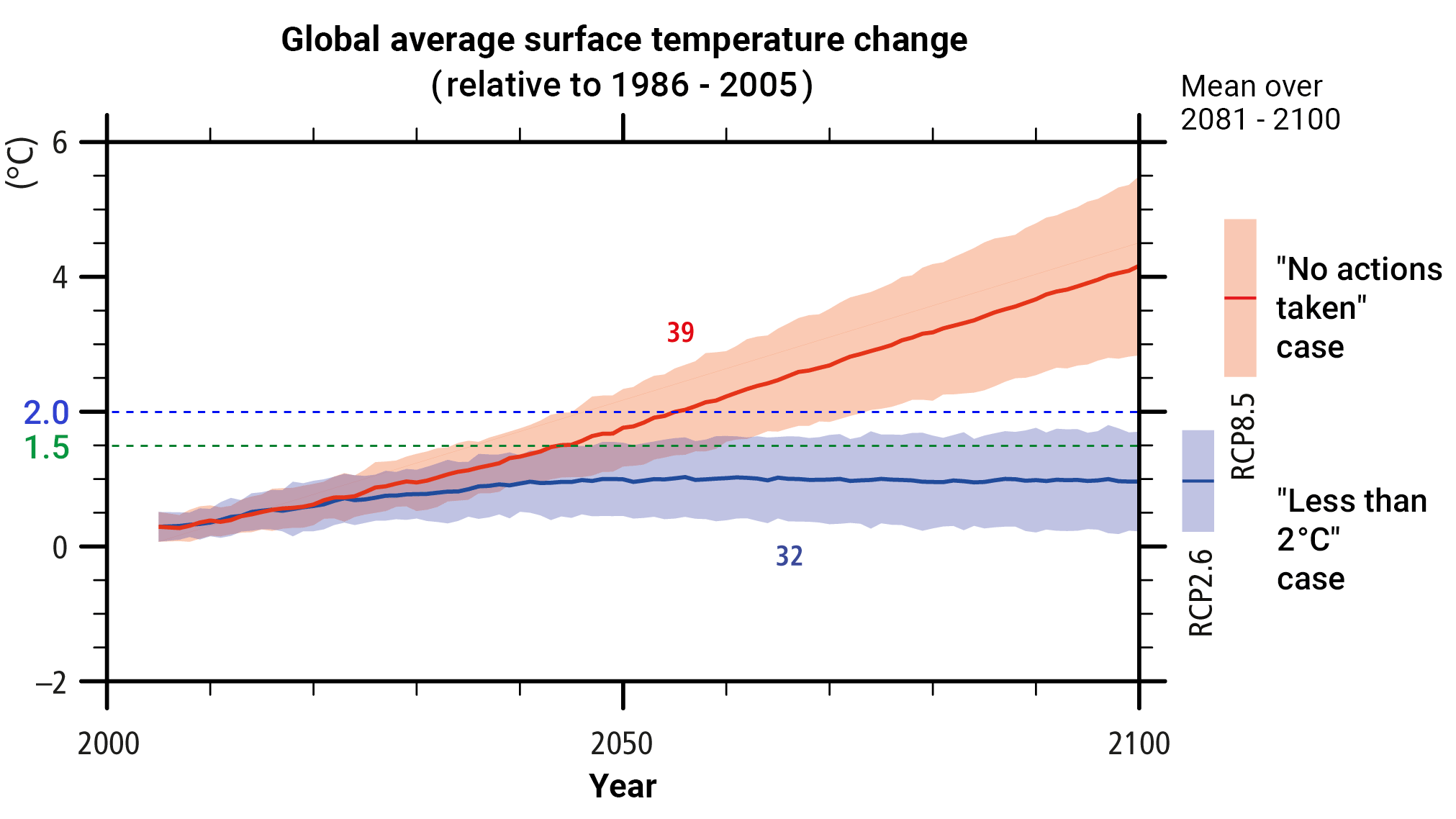
Source: Based on data from the IPCC Fifth Assessment Report
In the scenario corresponding to the pathway with the highest greenhouse gas emissions (RCP8.5 scenario), the global average surface temperature is predicted to rise by up to 4.8°C by 2100, causing a significant impact on human society and the ecosystem. The impact will vary considerably depending on to what degree the global temperature rise can be kept relative to pre-industrial levels. According to the IPCC's "Special Report on Global Warming of 1.5°C," in order to limit global warming to 1.5°C, CO2 emissions must be reduced by 45% from 2010 levels by 2030, and net zero emissions must be reached by 2050. Human activities have caused the global average temperature to rise by about 1°C from pre-industrial levels (likely in the range of 0.8°C to 1.2°C), and the impact on nature and human activities is already evident. (Abnormal weather, rising sea levels, and declining volume of Arctic sea ice, for example.) If global warming continues at the current rate, temperatures are likely to rise by 1.5°C between 2030 and 2052, and its possible impacts and risks have been reported.
Scenario Analysis
Physical Risks Associated with Climate Change
- 1. Sea level rise, coastal flooding
- 2. Flooding in megacities
- 3. Disruptions of infrastructure services, etc., due to extreme events
- 4. Deaths and illnesses due to heat waves
- 5. Threats to food security due to temperature rise, droughts, etc.
- 6. Income loss in rural areas due to water shortage and reduced agricultural production
- 7. Loss of marine ecosystems essential to the livelihoods of coastal areas
- 8. Loss of terrestrial and inland freshwater ecosystem services
Major Impacts
Sea Level Rise
[1.5°C] Global mean sea level rise is projected to be in the range of 0.26 to 0.77 m by 2100 (M), approximately 0.1 m less than for a global warming of 2°C (M), and up to 10 million fewer people would be exposed to related risks (M).
[1.5–2°C] Main ice sheet instability in Antarctica and/or irreversible loss of the Greenland ice sheet could result in multi-meter rise in sea level over hundreds of thousands of years.
Flooding
The percentage of major rivers impacted by flooding will increase with global warming. Relative to 1976—2005 levels, population affected by flood hazards is projected to increase by:
[1.5°C] 100% (M).
[2°C] 170% (M).
Food
A rise in temperature by more than 4°C from the level at the end of the 20th century, combined with an increase in food demand, may pose a significant risk to global and regional food security (H). This risk is greater in low-latitude regions.
[1.5°C] Compared with 2°C, smaller reductions in yields and less quality deterioration of cereal crops in sub-Saharan Africa, Southeast Asia, and Central and South America (H).
[2°C] Compared with 1.5°C, reductions in food availability are larger in the Sahel, southern Africa, the Mediterranean, central Europe, and the Amazon (M).
Ecosystems
Global warming is expected to alter the global distribution of marine species. In susceptible areas, biodiversity is expected to decline (H). Experts believe that many species will be unable to follow the climate suitable for habitation at a medium to high rate of climate change (M).
[1.5°C] Coral reefs are projected to decline by a further 70–90% (H). 6% of insects, 8% of plants, and 4% of vertebrates are projected to lose over half of their habitats.
[2°C] Over 99% of coral reefs are projected to be lost (VH). The irreversible loss of marine ecosystems increases (H). 18% of insects, 16% of plants, and 8% of vertebrates are projected to lose over half of their habitats.
Source: IPCC's "Special Report on Global Warming of 1.5°C"
VH: Very high confidence H: High confidence M: Medium confidence
Major Risks Associated with Transitioning to a Low Carbon Society
Regulatory Risks
Leveraging our technological strengths in small, high-performance engines, we develop a wide range of products including motorcycles, outboards, personal watercraft, boats, fishing boats, ATVs, golf cars, and generators, and market them around the world. Our core business of motorcycle engines is significantly affected by the emission standards of each country and territory. If we are unable to develop a product that conforms to the standards, we face the risk of losing sales opportunities.
With regard to this risk, the regulations and certification division collects information about regulatory trends in each country and territory. In addition, the Environmental Regulation Management Committee, chaired by the executive officer in charge of the powertrain technology development division and comprising the Quality Assurance Division, Production Control Division, Powertrain Development Section, Electronics System Development Division, and Combustion System Development Division, works to accelerate decision-making on the advance development of technology to address the tightening of regulations and on the development of powertrains, and to minimize risks associated with the strengthening of emission standards in each country and territory.
New Regulatory Risks
If tighter regulations such as a ban on inner-city use of motorcycles and other vehicles that run on fossil fuels are introduced not only in Europe and other environmentally advanced countries but also in emerging countries faced with severe air pollution, we will end up losing sales opportunities unless we respond by electrifying our motorcycles and developing battery charging infrastructure.
With regard to this risk, staff in charge of the environment collect information on moves made by national governments and trends related to energy policy, and report their findings at Environment Committee meetings. Each operating and functional division discusses and determines how to respond, reports its decisions to the Board of Directors, and reflects them in specific business strategies.
We conduct manufacturing operations for our main motorcycle business at 30 locations in 20 countries, mainly in the ASEAN region. A considerable amount of energy is used during manufacturing, particularly in the engine casting process as well as painting process. If countries and territories around the world introduce regulations mandating a shift from fossil fuels to renewable energy sources, we face the risk of becoming less competitive due to increased energy costs.
To minimize risks associated with the tightening of energy standards in each country and territory, the Manufacturing and Production Engineering Center and the environmental facility division collect information on regulatory trends concerning energy costs in each country and territory. Moreover, the Environment Committee deliberates and discusses energy-related investment plans, how to procure renewable energy, and other matters, and the findings are reported to the Board of Directors following a review by the Management Committee.
Information Disclosure Risks
If we fail to disclose a sufficient amount of information on the risks associated with climate change, we face the risk of a lawsuit being filed by stakeholders. With regard to this risk, staff in charge of the environment collect information on international trends related to information disclosure on matters concerning climate change, and report their findings at Environment Committee meetings. The Environment Committee deliberated and determined long-term environmental plans targeting 2050, as well as policies on how to respond to the SBTi and TCFD as an international requirement. It reported its decisions to the Management Committee and the Board of Directors, which voted on the matters. As a result, we declared our commitment to the SBTi in May 2018,
Technological Risks
Leveraging our technological strengths in small, high-performance engines, we develop mobility products with minimal environmental impact in terms of CO2 emissions and resource use, and market them around the world. Our efforts on the electrification of mobility vehicles date back to 1978 when we released an electric unit for golf cars, and in 1993 we launched PAS, the world's first electrically power assisted bicycle. By applying the control technology of the Robotics Business Unit, we are pursuing electrification of various product groups. For example, we released an electric unit for wheelchairs in 1995, an electric motorcycle in 2002, and an industrial-use drone in 2018.
Once manufacturers start accelerating their efforts to electrify automobiles and other vehicles, demand for rare earth will increase, potentially making it difficult to source raw materials. To address this risk, we are using materials and developing material technology that make less use of rare earth.
Market Risks
If governments introduce a ban on inner-city use of motorcycles and other vehicles that run on fossil fuels and similar regulations not only in Europe and other environmentally advanced countries but also in emerging countries faced with severe air pollution, we will end up losing sales opportunities unless we respond by electrifying our products and developing the necessary infrastructure. With regard to this risk for motorcycles, staff in charge of the environment collect information on moves made by national governments and trends related to energy policy, and report their findings at Environment Committee meetings. Each operating and functional division discusses and determines how to respond, reports its decisions to the Board of Directors, and reflects them in specific sales strategies.
Reputation Risks
Efforts made by companies to address climate change have a major impact on their corporate value such as ESG investments.
If we do not address climate change issues and disclose information to stakeholders appropriately, our corporate value may decrease.
To deal with this risk, staff with the Corporate Communication Division’s Investor & Shareholder Relations Group at Yamaha Motor headquarters
hold company information sessions for private investors as well as consultations for institutional investors.
To help prevent the spread of COVID-19 in fiscal 2020, we switched from meeting face-to-face to online meetings.
We also held 18 interviews specifically for ESG factors, explaining the company’s work on climate change as part of Yamaha’s environmental
and resource-focused initiatives for addressing key societal issues and in order to avoid reputational risks.
Customer Risks
We deliver products such as automotive engines, multi-purpose engines, and industrial robots to customers. Some of our corporate customers request suppliers that emit large amounts of CO2 to set CO2 reduction targets and disclose environmental information. Those that cannot meet these requests risk losing business in the worst case. To avoid facing this risk, our staff in charge of the environment collect and disclose information appropriately according to each customer's requests, making sure every requirement is met.
Short-term, Medium-term, and Long-term Risks and Opportunities
We discuss short-term, medium-term, and long-term risks in the following time frames.
| Short-term Risks |
Risks that may have an immediate impact on business performance (including risks that may materialize in a period of 0 to 3 years) |
|---|---|
| Medium-term Risks |
Risks that may have a significant impact on our business performance through the materialization of long-term climate-related impacts, and that may necessitate a major adjustment of our strategies (including risks that may materialize in a period of 3 to 6 years) |
| Long-term Risks |
Risks that may radically impact the feasibility of our long-term strategies and business models (including risks that may materialize in a period of 6 years or more) |
We evaluate the materiality of climate-related risks based on whether they are likely to materialize in the short term, medium term, or long term, and the estimated scale of the resulting financial impact.
Short-term Risks (0–3 Years)
In the motorcycle market, many governments have tightened or are planning to tighten emission standards. Since our products are subject to these standards, costs required to ensure compliance will increase. If these costs cannot be absorbed, they will be passed on to retail prices, which will make our products less competitive and may reduce operating income.
In 2020, Europe has moved to more stringent Euro 5 emission standards. ASEAN, India, and China tend to introduce regulations based on European standards three to five years later. India, where 21 million new vehicles are sold in a year, is a critical market for Yamaha Motor, and increased compliance costs will pose a significant risk to our product competitiveness and have a major financial impact.
Net sales of two-wheelers in emerging countries in FY2020 were 604 billion yen. If the sales price of a new vehicle rises due to higher costs to meet regulations and sales volume of two-wheelers in emerging countries were to decline by 30%, there would be a 181.2 billion yen fall in sales.
Our regulations and certification division collects information about emission standards in each country. This information is reflected in product plans for our motorcycle business as required. In developing fuel-efficient engines and electric motor products, we seek to increase product appeal by improving power performance and rideability at the same time, instead of simply conforming to regulations. In other words, we are striving to increase profit by enhancing added value, as exemplified by our BLUE CORE engines.
In terms of risk management, local sales divisions obtain the latest information on the tightening of regulations and report the findings to development divisions. Our global models are developed to conform to European standards as a measure to minimize risks in case ASEAN, India, and other countries suddenly decide to tighten their regulations.
R&D expenses for motorcycle development to meet regulatory compliance risks were 69.8 billion yen in FY2020.
As for marine engines, the U.S. EPA and CARB emission standards, which already cover the inboard and sterndrive engine categories, are slated to be further enhanced going forward. Our outboards boast a global share of more than 40% and maintain an overwhelming advantage in the market. However, if these standards are applied to outboards and sport boats as well, compliance costs will increase. If these costs cannot be absorbed, they will be passed on to retail prices, which will make our products less competitive and may reduce operating income.
Our regulations and certification division collects information about regulations concerning air pollution in each country. This information is reflected in product plans for our marine business as required. In developing fuel-efficient engines and lighter hulls, we seek to increase product appeal by improving power performance and comfort at the same time, instead of simply conforming to regulations. In other words, we are striving to increase profit by enhancing added value. In terms of risk management, local sales divisions obtain the latest information on the tightening of regulations and report the findings to development divisions. As a leading company in the marine industry, we are pursuing plans to achieve 4 STAR Voluntary Standards (2015–2020 exhaust emission standards) ahead of time to minimize associated risks.
Medium-term Risks (3–6 Years)
If the electrification of mobility vehicles accelerates worldwide in response to climate change issues, there would be a shortage of rare resources, such as nickel and cobalt, that are needed for storage batteries, resulting in an increase of procurement costs.
CO2 emissions from raw materials (Scope 3 / Category 1) account for 13.1% of the lifecycle CO2 emissions of Yamaha Motor products. Including suppliers in our initiatives has become important as we aim for net-zero CO2 emissions by 2050.
According to a Carbon Pricing Leadership Coalition (CPLC) report, if it is assumed that countries will achieve the targets that they pledged to in the Paris Agreement the carbon tax would reach 100 dollars/t-CO2 by 2030. If CO2 emissions for Yamaha Motor’s raw materials procurement are the same as those in FY2020, the estimate using the aforementioned carbon tax amount is an annual increase of 34 billion yen in costs.
In regard to risk management, the environmental facility division and the procurement division are collaborating since 2019 to provide support for the promotion of environmental activities among suppliers. Specifically speaking, those suppliers that are thought to have a large environmental impact are chosen from among domestic and overseas Yamaha Motor suppliers, after which the environmental facility division measures power and identifies losses and offers advice and expertise toward achieving net-zero CO2 emissions.
Long-term Risks (6+ Years)
As consumers become more environmentally aware, they may start avoiding gasoline-powered products, reducing our sales and profits. We pursue diverse business operations based on a core strength in small, lightweight engines, offering products ranging from motorcycles and outboards to golf cars and generators. As such, we will be severely impacted if the use of fossil fuels is banned.
To address this risk , we will develop mobility products that use next-generation power sources instead of fossil fuels (electric motorcycles, PAS, low-speed electric land cars, etc.) and propose sharing services in collaboration with local governments. We will also expand robotics and other solution businesses. In terms of risk management, we will push ahead with collaboration with partners to ensure our products are incorporated into the social infrastructure, keeping an eye on the CASE* trends in the automotive industry. To make sure we do not miss any opportunity in expanding market areas, we are studying combinations of our proprietary technologies, carrying out M&As as necessary, in an effort to reduce the risks that we will face if the use of fossil fuels is banned.
* CASE refers to "connected" cars, "autonomous" driving, car "sharing and services," and "electric" vehicles, which are the four major trends that the automotive industry must pursue in the next generation.
Each year, we manufacture motorcycles around the world, with Indonesia (31%), India (17%), and Vietnam (17%) accounting for 65% of the production volume. In climate pledges drafted under the Paris Agreement, Indonesia set a CO2 reduction target of 29% (41% with cooperation from developed countries), India 33–35%, and Vietnam 8% (25% with cooperation from developed countries) by 2030. If the governments of these three countries, where our major production bases are located, make it mandatory for factories to report CO2 emissions and introduce fines for failure to meet reduction targets, there will be major impacts on our business operation, including financial impacts. In 2020, 442 thousand tons of CO2 were emitted from production activities.
According to a report by the Carbon Pricing Leadership Coalition (CPLC), carbon taxes will reach 100 dollars/t-CO2 by 2030, assuming that all signatories to the Paris Agreement meet their reduction targets. Given that our CO2 emissions from production activities are the same as in 2020, the increase in costs based on the above carbon taxes is estimated to be between 4.8 billion yen per year. The Manufacturing and Production Engineering Center at our headquarters monitors CO2 emissions from the production activities at all manufacturing sites, and provides guidance to help them achieve reduction targets. Each production base constantly monitors trends related to environmental regulations in the country where it operates. Other environmental trends including regulations are being followed by the secretariat of the Environment Committee at our headquarters, and important relevant matters are submitted to the Environment Committee for deliberation.
Yamaha Motor's Adaptation Measures
Urgent Physical Risks
Our major manufacturing bases are concentrated in the ASEAN region, and factories located in the Philippines and Thailand, where typhoons pass over, face operational risks such as flooding of factory floors due to heavy rains.
To prepare for such risks, Companywide risks including natural disasters, violations of laws related to product quality, critical product accidents, and cybersecurity are incorporated into the activity policies of each headquarters division and overseas Group company, and those that we particularly need to focus on to prevent and address are established as significant risks at the Group level. Based on the Rules of Risk Management, we established the Sustainability Committee, chaired by the President and Chief Executive Officer, to monitor the overall risk status of the Group, as well as designating significant risks at the Group level to be tackled as priorities and checking on activities to address risks, in an effort to reduce Groupwide risks. In addition, to prepare against envisioned risks that could impact the continuity of our business, we have formulated the Rules of Business Continuity, which seek to minimize damage through appropriate response.
Chronic Physical Risks
Increased flood damage due to climate change spreads the pollution of water sources, deteriorating people's health conditions and adding to the number of the sick, which in turn impede social and economic development.
To address this risk, our staff in charge of the environment collect relevant information, evaluate water risks in each country based on water withdrawal and water stress using Aqueduct, a tool made available by the World Resources Institute (WRI), and implement measures according to the level of water risk to minimize water use. In addition, we developed a small water purification system called the Yamaha Clean Water Supply System to help improve people's health conditions and contribute to social and economic development through a new business, and started introducing it around the world in 2010. Adaptation measures in the area of water supply consist of addressing water pollution caused by climate change and improving people's health conditions and the social and economic environment. As of the end of March 2020, we have installed 41 units in 14 countries.
Global warming is raising concerns worldwide that it will have negative impacts on the agricultural field, such as reduction of farmland, fluctuations in yield, and movement of land suitable for cultivation due to temperature rise, droughts, floods, and other factors.
We will contribute to the realization of sustainable agriculture by providing a solution that uses our YMR-08 multi-rotor agricultural drones and industrial-use unmanned helicopters to conduct highly efficient and accurate pest control and top-dressing operations, and manage spraying data to increase the value and efficiency of spraying operations. Moreover, to enhance the value of using this service in areas such as crop growth analysis, field soil analysis, optimal fertilization planning, and load reduction of pesticide spraying work, we are collaborating with various partners. These include Kokusai Kogyo Co., Ltd., which provides Appare, a service that works to improve farming productivity using satellite image analysis; TOPCON Corporation, which offers Crop Spec, laser-based crop sensors indispensable in the operation of a variable top-dressing system; and WaterCell Inc., which offers agri-note, an agricultural support system that can unify the management of process data for a series of agricultural work.
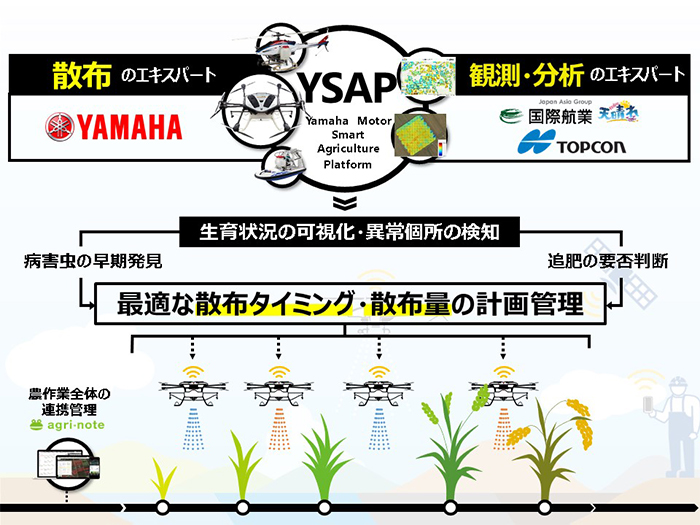
A software service that uses smartphones and computers to manage data and operations of pesticide spraying and fertilization work performed by YMR-08 and industrial-use unmanned helicopters
Yamaha Motor's Mitigation Measures
Spread of the Popularization of Low-carbon and Electrified Products that Contribute to the Reduction of CO2 Emissions
A characteristic of the family of products offered by Yamaha Motor is that they are lightweight and compact. Among mobility solutions, they not only have a low environmental load in terms of the use of resources during manufacturing, but they are also highly maneuverable during their use. The products enable free and easy movement over short distances.
The Asia region accounts for 80% of Yamaha Motor’s two-wheeler sales. From the perspective of the SDGs, our products contribute to the region to fulfilling the needs for the mobility of goods and services, expanding spheres of life, and increasing occupational options and opportunities for education as a compact, convenient, and inexpensive mobility solution.
Centering on customers requiring internal combustion engines in Asia, where the majority of the owners of our products are located, we are contributing to the simultaneous achievement of both economic growth in developing countries as well as a response to environmental issues by providing products with better fuel efficiency. Going forward, we will aim toward the achievement of global, carbon neutral societies by offering a product portfolio that gives consideration to the energy policies and energy mix of various countries and regions and is most effective in reducing CO2 emissions (e.g., through electrified models and next-generation mobility solutions that use renewable energy as power sources).
Compact Mobility Vehicles with Low environmental impact
Yamaha Motor proposes compact mobility vehicles with low CO2 emissions and Low environmental impact throughout their life cycle, from raw materials to manufacturing, use, and disposal. For example, the CO2 emissions of two-wheeler vehicles are less than those of four-wheelers. In terms of the whole product life cycle, CO2 emission amounts are 70% less for ICE vehicles, and 75% less for Battery Electric Vehicles at the raw materials stage.
More effective CO2 emission reduction can be achieved through the reduction of CO2 emissions during the manufacture of batteries, and excellent charging facilities that utilize renewable energy sources.

[ Assumptions for the Estimate ]
Four-wheeler ICE/BEV: IEA standard; Two-wheeler ICE: Yamaha Motor 125 cc; Two-wheeler BEV is a Yamaha Motor BEV of a similar output class to the aforementioned; driving distance per year: 15,000 km; duration of use: 10 years
[ Four-wheeler data reference ] Global EV Outlook 2020 (IEA)
※ICE: internal combustion engine ※BEV: Battery Electric Vehicle
Promotion of Electrically Power Assisted Bicycles
Prompted by an awareness of global environmental issues and the social issues of a declining birthrate and an aging population, which came to the fore in the 1980s, we embarked on the development of a new vehicle that did not belong to any existing category. Our development concept: "a personal commuter that is both people friendly and environmentally friendly, and places top priority on human sensibilities." This effort culminated in the 1993 launch of the PAS, the world's first electrically power assisted bicycle. Since then, we have developed various businesses around this product, including the sales of completed vehicles and supply of drive units in Japan, as well as the global supply of system kits for electrically power assisted bicycles starting in 2012, based on enhanced and expanded collaboration with European bicycle manufacturers. In February 2019, cumulative production of drive units for electrically power assisted bicycles reached 5 million units.
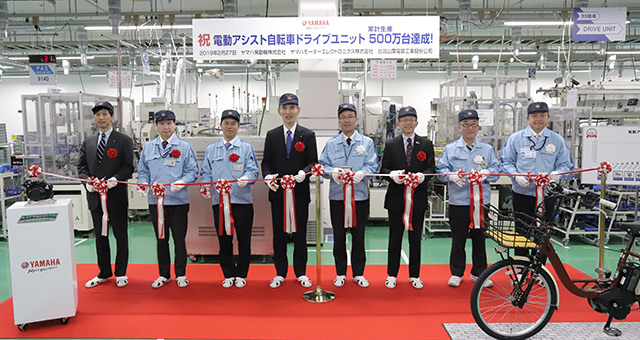
(Main Factory of Yamaha Motor Electronics Co., Ltd.)
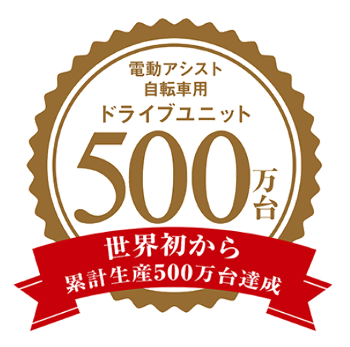
Global Implementation of Theoretical Value Energy Activities in Production Operations
At Yamaha Motor, we are working to reduce CO2 emissions of the entire Group by cooperating with overseas Group companies, sharing energy-saving know-how accumulated within Japan. Specifically, we are implementing a "theoretical value energy" approach, in which we define the value and quasi-value of each facility and process at our production bases in Japan and abroad, identify the essential functions, and aim to minimize loss. To date, we have visited 30 locations in 13 countries, covering 98% of Groupwide CO2 emissions, in our effort to reduce energy loss.
Theoretical Value Energy
In this approach, we pursue energy minimization by defining the energy theoretically required in facilities and processes as "value energy," and thoroughly eliminating quasi-value and non-value areas through improvements in both facilities and operations. We are implementing this approach at suppliers as well as Group companies in Japan and overseas.


Expanding Use of Renewable Energy at Production Sites
We are installing power generation systems that use solar and wind power. Following the installation of a solar power generation system at the Main Factory in 2004, these systems have been successively installed elsewhere and the use of renewable energy is expanding. Installations continue at overseas locations including in the United States, Thailand, and Taiwan, and in 2019, solar power generation systems were introduced at production sites in India. The amount of power generated in 2020 by the whole Group totaled 14,886 MWh and was used for various factory operations, office lighting and air conditioning.
Yamaha Motor’s Net-zero CO2 Emissions (Carbon Neutrality) Strategy
Yamaha Motor has been working to solve global environmental issues since the 1980s. In 1993, we released PAS, the world’s first electrically power-assisted bicycle. Then in 2002, we introduced Passol, an electric scooter for urban commuters. Since then, we have continued to expand electrification to various other categories, including golf carts, wheelchairs, and outboard motors.
PAS, which was developed under the concept of “a personal commuter that is both people- and environmentally-friendly and places top priority on human sensibilities” created a new vehicle that did not belong to any existing category, such as bicycle or motorcycle. Today, PAS has continued its growth in Japanese urban areas as a mobility vehicle that takes the place of mopeds and mini cars. Its market is growing in Europe and the U.S. as an e-bike, a new category, for sports and leisure use. In addition to two-wheelers, we will continue proposing new value through uniquely Yamaha-like mobility vehicles toward achievement of a carbon-neutral society in 2050.
Basic Policy
- Switch to efficient sources of power with smaller CO2 emissions.
- Promote the utilization of compact mobility vehicles with a low carbon footprint.
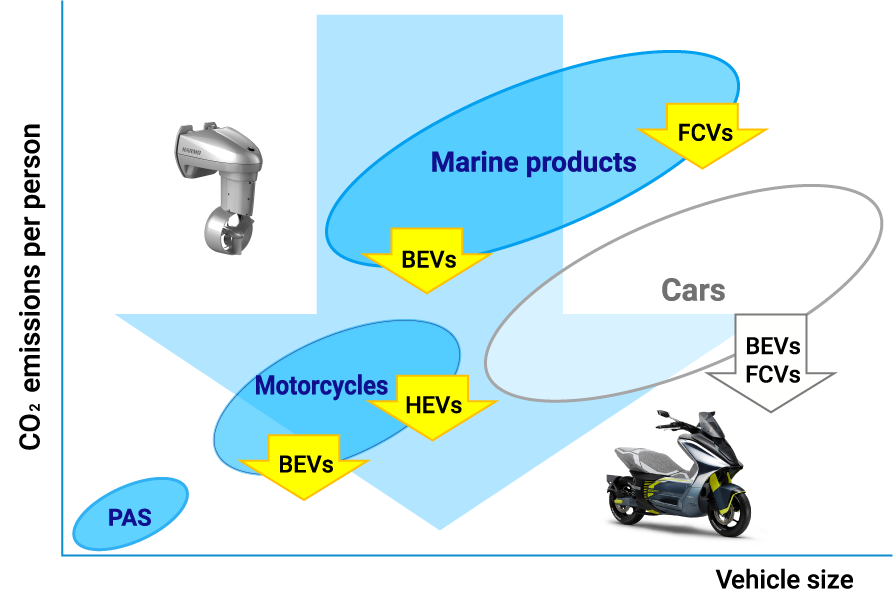
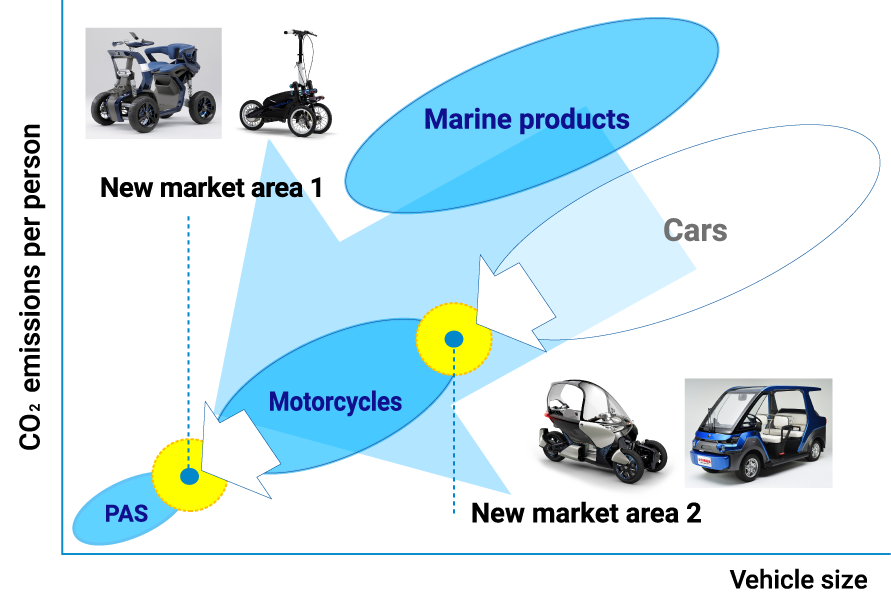
Electrification Strategy

Yamaha Motor will undertake: 1. the improvement of the fuel efficiency of ICE systems, 2. expansion of the lineup of electrified models and their popularization, and 3. the development of power trains powered by renewable energy.
In regard to the Electrification Strategy, an important point related to product roll out is to take CO2 emission reduction into consideration and consider the state of the diffusion of electricity generated through renewable energy sources and development of a supply infrastructure in a country or region.
We will work toward achievement of net-zero CO2 emissions (carbon neutrality) by 2050 by first rolling out products in Europe, which has a high rate of the use of renewable energy to generate electricity. Between 2030 and 2035, we will then move onto the ASEAN region, which is a high-volume zone in terms of CO2 emissions.


In relation to outboard motors, we will engage in the following as the technological strategy toward achievement of net-zero CO2 emissions (carbon neutrality). 1. Improvement of the fuel efficiency of ICE systems, 2. Development of electrified models, and 3. The development of models that use hydrogen, e-fuel, and other renewable energy as sources of power.
The sales composition of outboard motors is 60% in industrialized countries and 40% in emerging countries and developing countries. In industrialized countries, they are primarily used for fishing, marine sports and other leisure activities. Meanwhile, their use in emerging countries and developing countries is mainly focused around supporting people’s livelihoods, such as through fisheries. Their usage environments are also harsh.
Because Yamaha Motor rolls out electrified models while keeping an eye on the state of the spread of the infrastructure for the supply of renewable energy as well as the suitability level of a country or region’s usage environment, the roll out of electrified models is carried out sequentially beginning with industrialized countries. They are then deployed to other regions. By doing so, we are contributing to net-zero CO2 emissions (carbon neutrality) as the most trusted brand.

We have assumed the achievement of technical innovation in CN fuels (e.g., Hydrogen, Biofuel, Synthetic Liquid Fuels, etc.) and have made CN fuel adoption rates of 2.6% in 2030, 20% in 2035, and 30% in 2050 the preconditions.
Going forward we will continue to review our measures as needed toward achievement of carbon neutrality by 2050. We will do so by engaging in the analysis of future forecast scenarios drafted by the IEA and others, obtaining an understanding of the electrical power supply composition policies and infrastructure circumstances of various countries and regions, and developing environmental technology that anticipates trends in carbon-neutrality technology.
| Main axis | Technological response | Effect | |
|---|---|---|---|
| ICE (internal combustion engine) | Enhancement of the efficiency of engines and drive trains | Fuel improvement | |
| HEVs (the main axis is motorized in S-HEVs) | |||
| De-carbonization of fuel | Synthetic Liquid Fuels | De-carbonization | |
| Hydrogen | |||
| Motorized | BEV | ||
| FCV (hydrogen fueled) | |||
ICE: Internal Combustion Engine; burns fuel to acquire moving force.
HEV: Hybrid Electric Vehicle; driven through the combination of an engine and motor.
BEV: Battery Electric Vehicle; drive a motor using battery power.
FCV: Fuel Cell Vehicle; power is generated using fuel cells to drive a motor.
CN fuel: Carbon-neutral fuel; moving force is acquired by burning Hydrogen, Biomass, Synthetic Liquid Fuels, and other renewable fuels.
Synthetic Liquid Fuels: Fuel obtained by synthesizing hydrogen and CO2, which are obtained by electrolyzing water with renewable energy.
3. Risk Management

Process of Identifying and Evaluating Climate-related Risks
We identify and evaluate climate change risks from two perspectives: business strategy and business continuity.
Identification of Risks
Each operating division and functional division categorize short-term, medium-term, and long-term climate-related risks into "risks related to transitioning to a low-carbon economy" and "risks related to physical changes caused by climate change." Then, they consider the financial impacts of these risks on business, as well as the financial impacts on business with climate change mitigation measures and adaptation measures as opportunities for management reform, and identify risks and opportunities in the medium-term business plan.
Companywide business continuity risks including climate-related risks, violations of laws related to product quality, critical product accidents, and cybersecurity are incorporated into the activity policies of each headquarters division and overseas Group company, and those that we particularly need to focus on to prevent and address are identified as significant risks at the Group level. In this manner, climate-related risks are incorporated into the Groupwide system for risk management.
Evaluation of Risks
The Environment Committee, chaired by the executive officer in charge of environment activities, evaluates specific initiatives undertaken as a business strategy on risks and opportunities identified by each operating division and functional division.
The Sustainability Committee, chaired by the President and Chief Executive Officer, evaluates specific initiatives on significant risks at the Group level, particularly Companywide business continuity risks, including climate-related risks, that the Company needs to focus on to prevent and address. In this manner, climate change-related risks are incorporated into the Groupwide system for risk management.
Process of Managing Climate-related Risks
The Environment Committee manages the annual progress toward the goals and targets of specific initiatives undertaken as a business strategy on risks and opportunities identified by each operating division and functional division. It reports results to the Sustainability Committee, which consists of the same members as the Management Committee, and the Board of Directors.
Specifically, each operating division and functional division considered short-term, medium-term, and long-term risks and opportunities, their business, strategic, and financial impacts, and in terms of physical risks, RCP2.6 and RCP8.5 scenarios, and migration risk, IEA 2DS, IEA B2DS and NDCs scenarios were considered. Specific figures for the 2030 targets (and 2035 targets) were formulated. The Environment Committee manages progress and deliberates matters that have a significant impact on business, and submits reports or resolution matters to the Board of Directors at least twice a year.
4. Indicators and Targets

Setting 2030 and 2035 milestones
Initiatives for "Climate Change"
※NDCs: Nationally determined contributions are the GHG reduction targets, measures, and efforts toward target achievement determined by each country on the basis of the Paris Agreement.
※ICE: Internal Combustion Engine; burns fuel to acquire moving force.
※BEV:Battery Electric Vehicle; motors are driven by battery power.
※CN fuel: Carbon-neutral fuel; moving force is acquired by burning Hydrogen, Biomass, Synthetic Liquid Fuels, and other renewable fuels.
※Synthetic Liquid Fuels: Fuel obtained by synthesizing hydrogen and CO2, which are obtained by electrolyzing water with renewable energy.
Initiatives for "Resource Recycling"
Reduce waste generated by production activities
- Raise awareness of a globally shared definition of waste materials
- Obtain a grasp of waste amounts utilizing a global tabulation system
- Carry out on-site surveys, extract and grasp issues
Reduction of water usage in production activities
- Continue obtaining an understanding of the water consumption amounts of each Group company
- Aim to minimize water risks* through measures corresponding to the water risks of each country and region
* Water risks are indexes related to water supply and demand that were uniquely established by Yamaha Motor using Aqueduct, published by the World Resources Institute, and other materials as reference
Environmental Management
2050: Eliminate all harmful substances contained in products
2030: Strengthen compliance with environmental laws and regulations, and control of chemicals in products
- Reduce environmentally hazardous substances in products
- Risk management of the control of environmentally hazardous substances
